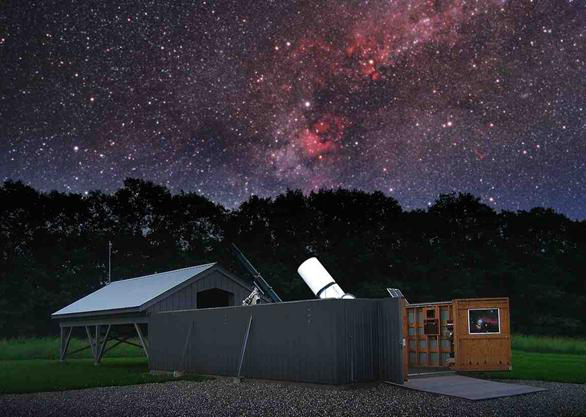
An observatory has been a dream of the Club for many years and now it is a reality. On July 21,2001, the Club opened the Starfield Observatory. We will now be able to dramatically increase our role in educating children and the public about astronomy. With a "home base" we now expect-and want the Observatory to become a destination venue for school classes, scout troops, community organizations and anyone else with an interest learning about the sky above us.
Our site, located on Rte. 35 near the Kennebunk-Lyman town line, (Latitude 43 degrees 27.28 minutes north and Longitude 70 degrees 36.15 minutes west), consists of a 3.5 acre parcel in the northeast corner of a 40 acre field. Our acquisition was made possible by the generosity of the former owners, Dan Fleishman and Claudia Berman, who sold the property to us at far below market value.
The building itself was erected in the fall and winter of 1999-2000 exclusively with volunteer labor from club members. The design consists of five-foot high stud walls surfaced with metal siding. The roof is constructed with scissor trusses to add headroom, and metal sheathing to accommodate a cooler interior. The roof rolls completely off onto a frame located behind the building to the north. Wide doors on the south end allow easy access and makes the facility handicapped accessible. The wall height will block wind, adding comfort to viewing. The roll-off roof permits the telescopes to be prepared quickly for use, and unlike a dome, provides a full view of the sky.
The telescope pedestals are anchored to massive concrete piers installed five-feet deep. The piers isolate the instruments from any vibrations. Accessories are be stored in low corner cabinets, with the tops of the cabinets serving as a workspace for star charts and other observing aids.
The observatory does not require insulation or a heating system as it must remain as close to ambient temperature as possible. An independent solar electrical system has been installed which provides electricity to run the telescope drives, computers and other equipment. Lighting is designed for night vision protection.
Our two telescopes consist of a 16" Meade LX200 GPS Schmidt-Cassegram (pictured in the foreground above) and an 8" f/15 Zeiss-Jena refractor (pictured in the background above). The Meade LX200 is a fully computerized scope with "Go-To" capabilities. The Zeiss-Jena is also outfitted for safe daytime viewing of the sun through its Hydrogen-Alpha filter system. Both scopes will provide stunning views of galaxies and other deep sky objects as well as for CCD and film camera work.
(Lat. 43 degrees 27 minutes, 17 seconds, N. Long. 70 degrees 36 minutes 9 seconds W. Elevation 163 feet)
© 2016 ASNNE